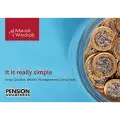Many investors are aware of the tax benefits of investing in Individual Savings Accounts (ISAs) which allow savers to invest up to £20,000 in each tax year with no tax liability on any growth or interest generated. Using the annual ISA allowance can, over time, result in a substantial fund being generated and a significant potential saving of income tax and capital gains tax (CGT) when compared to other forms of investment.
However, ISAs can become less attractive in later life, simply because they are inflexible when it comes to Inheritance Tax (IHT) planning.
More and more families are facing IHT bills as reliefs and exemptions remain unchanged while property values and savings continue to appreciate. IHT is paid on the value of the estate left to your beneficiaries on death, with the first £325,000 of an individual’s assets being free from IHT (this is referred to as the ‘nil rate band’), and everything over this level is taxed at 40%. In 2017, the Government introduced an additional IHT allowance, called the ‘residence nil rate band’ which stands at £175,000 per individual and, assuming certain criteria are met, allows your home to qualify for this additional relief. However, the current nil rate band has not changed since 2009 and is now frozen until 2028.
Many people undertake estate planning to ensure their savings, investments and property create a legacy for their families to provide them with financial security, or perhaps help children or grandchildren reduce their mortgage or fund school or university costs.
While there are a range of tax planning solutions available to potentially reduce the IHT liability, this normally does not extend to ISAs. ISAs cannot be held jointly or placed in trust for beneficiaries, and this means that ISA portfolios often form part of the deceased’s taxable estate on death.
However, there is a way in which ISAs can be protected from IHT, simply by changing the underlying investments held.
The Alternative Investment Market (AIM) is now well established, having a track record of over 25 years, and is the home for small and medium sized, growth orientated businesses across all sectors and industries. Many well-known companies started life listed on the AIM market, including ASOS, Fevertree Drinks, Majestic Wine, Jet2… and Mattioli Woods!
Private investors can buy shares in AIM listed companies, and one of the attractions of doing so is that investment in qualifying businesses attracts Business Relief (BR), which allows AIM investments to become IHT exempt after a period of only two years.
BR is a valuable relief from inheritance tax, allowing certain investments to be left to beneficiaries free from inheritance tax. BR, previously known as Business Property Relief (BPR) is well established, having been introduced in 1976 to ensure that inheritance tax was not paid on small businesses.
This remit has widened and today BR is aimed at incentivising people to invest their money into certain trading businesses, with the added incentive of providing a faster route to IHT exemption than other estate planning methods, such as gifting or using trusts.
The investment becomes exempt from IHT after being held for two years (provided the shares are still held at the time of death and continue to be BR qualifying). And the tax benefits get even better as an investment in AIM can be held within an ISA ‘wrapper’ which, as we know, does not give rise to any liability to income tax or CGT.
So, how do you go about selecting the appropriate, qualifying shares to hold within your AIM portfolio? The first point to note is that not every AIM listed company will qualify for BR relief, so selection must be done carefully to ensure the portfolio is constructed in an appropriate manner, and most individual investors probably do not have the time, knowledge or inclination to research this area.
Therefore, we believe that specialist knowledge is vital when managing AIM IHT portfolios. Within Mattioli Woods we are delighted to be able to engage with our colleagues at Amati Global Investors (“Amati”) who have many years’ experience of investing in the BR market. Amati was established in Edinburgh in 2010 with the objective of providing investors with savings and investments offering exposure to dynamic areas of the market, and has become specialists in small and medium sized companies, creating diverse portfolios capable of performing in a variety of market conditions.
The Amati IHT portfolio service gives investors access to a selection of 25-40 qualifying AIM-listed companies. The portfolio is actively manged and includes a broad range of sector exposure, with substantial weightings in healthcare and technology, across business with market capitalisations from around £100 million to £2 billion.
AIM shares are exposed to a number of risk factors that may impact overall share price performance. It is very important you fully understand these risks so you can decide whether it is right for you. As with any investment, the value of the shares may go down as well as up and you may not receive the full amount invested. Funds placed in an AIM portfolio should be considered a medium to long-term investment reflecting the volatile nature of share prices, especially those listed on smaller markets.
Tax legislation is subject to change at any time and any tax advantages may be amended or withdrawn. Each company’s qualification is subject to HMRC approval at the time of disposal of the shares. The provider of an AIM portfolio may be registered with the Financial Services Compensation Scheme (FSCS) which protects eligible clients against loss in certain circumstances. However, there are no guarantees protecting your capital, like any direct equity investment.
Clearly, as highlighted above, AIM investment can carry some risk, and certainly is not for everyone. It is said that the only certainties are ‘death and taxes’. However, the ability to remove your ISA portfolio from the clutches of IHT is certainly worthy of consideration. Perhaps the ‘perfect’ tax planning investment is one that provides exemption from all three of the major taxes; income tax, capital gains tax and inheritance tax, and holding an AIM portfolio with an ISA ‘wrapper’ could do just that.
All content correct at time of writing (February 2024).

































































































































































































